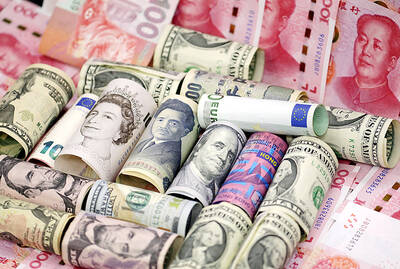Innolux Corp (群創) chairman Tuan Hsing-chien (段行建) yesterday said he is leaving for Sharp Corp to help the Japanese firm integrate its LCD business with Innolux’s, especially in developing next-generation indium-gallium-zinc-oxide (IGZO) and organic light-emitting diode (OLED) display technologies.
Tuan resigned from his posts as chairman and chief executive officer of Innolux, an LCD manufacturing arm of Hon Hai Precision Industry Co (鴻海精密).
His resignation coincides with Sharp’s nomination of Hon Hai vice chairman Tai Cheng-wu (戴正吳) as its new president, after the Osaka-based firm agreed a US$3.5 billion stake sale to Hon Hai last month.
“My role is to help enhance the competitiveness of Sharp’s LCD business,” Tuan told a media briefing. “In the meantime, I hope to explore opportunities of cooperation between Sharp and Innolux. I hope to create a win-win situation.”
The Japanese company in recent years has experienced a similar situation as Taiwanese firms had, sandwiched between Chinese and South Korean rivals, Tuan said.
“The cooperation between the two nations will help [solve the problem],” he said.
Hon Hai chairman Terry Gou (郭台銘) has not offered details about his new job at Sharp yet, Tuan said.
IHS Technology senior director of market research David Hsieh (謝勤益) said Tuan is a good candidate to help Hon Hai integrate Innolux’s and Sharp’s LCD businesses, given his experience in merging Innolux with Chimei Optoelectronics Corp (奇美電子) and TPO Display Corp (統寶電子) in 2013.
Tuan said IGZO technology is one potential area where Innolux can collaborate with Sharp, as the technology can be used in high-resolution displays for tablets, notebook computers and TVs.
Innolux said IGZO would have advantages in cost, picture resolution and power consumption over other display technologies in the next five to 10 years.
The company is adjusting its equipment to make mid-sized IGZO panels on its own and expects to begin mass production by the end of this year at the earliest, it said.
In addition to IGZO technology, “OLED [technology] is a major consideration for Hon Hai’s investment in Sharp,” Tuan said.
Sharp and Innolux lag behind Samsung Electronics Co in developing this technology and have to catch up rapidly, he added.
Innolux, which is developing OLED technology to make displays for smartphones, has a chance to ramp up production in 2018 at a 4.5-generation factory, while mass production from a Sharp sixth-generation plant might start in 2019, he said.
Innolux and Sharp are complimentary to each other in terms of LCD panel capacities, Tuan said.
“Innolux might buy some glass substrates it lacks from Sharp,” he added.
Sharp focuses on making 65-inch, 70-inch and 80-inch TV panels, while Innolux makes a wide range of panels from 40-inch to 65-inch, he said, adding that combined, the companies can produce a good lineup.
Innolux’s board of directors yesterday approved Tuan’s resignation and the appointment of company president Wang Jyh-chau (王志超) to fill the vacancy. Wang is to double as company president. However, Tuan is tapped as an honorary chairman of Innolux. The personnel adjustments are effective starting today.

Taiwan’s foreign exchange reserves hit a record high at the end of last month, surpassing the US$600 billion mark for the first time, the central bank said yesterday. Last month, the country’s foreign exchange reserves rose US$5.51 billion from a month earlier to reach US$602.94 billion due to an increase in returns from the central bank’s portfolio management, the movement of other foreign currencies in the portfolio against the US dollar and the bank’s efforts to smooth the volatility of the New Taiwan dollar. Department of Foreign Exchange Director-General Eugene Tsai (蔡炯民)said a rate cut cycle launched by the US Federal Reserve

The US government on Wednesday sanctioned more than two dozen companies in China, Turkey and the United Arab Emirates, including offshoots of a US chip firm, accusing the businesses of providing illicit support to Iran’s military or proxies. The US Department of Commerce included two subsidiaries of US-based chip distributor Arrow Electronics Inc (艾睿電子) on its so-called entity list published on the federal register for facilitating purchases by Iran’s proxies of US tech. Arrow spokesman John Hourigan said that the subsidiaries have been operating in full compliance with US export control regulations and his company is discussing with the US Bureau of

Businesses across the global semiconductor supply chain are bracing themselves for disruptions from an escalating trade war, after China imposed curbs on rare earth mineral exports and the US responded with additional tariffs and restrictions on software sales to the Asian nation. China’s restrictions, the most targeted move yet to limit supplies of rare earth materials, represent the first major attempt by Beijing to exercise long-arm jurisdiction over foreign companies to target the semiconductor industry, threatening to stall the chips powering the artificial intelligence (AI) boom. They prompted US President Donald Trump on Friday to announce that he would impose an additional

Pegatron Corp (和碩), a key assembler of Apple Inc’s iPhones, on Thursday reported a 12.3 percent year-on-year decline in revenue for last quarter to NT$257.86 billion (US$8.44 billion), but it expects revenue to improve in the second half on traditional holiday demand. The fourth quarter is usually the peak season for its communications products, a company official said on condition of anonymity. As Apple released its new iPhone 17 series early last month, sales in the communications segment rose sequentially last month, the official said. Shipments to Apple have been stable and in line with earlier expectations, they said. Pegatron shipped 2.4 million notebook